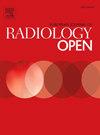用于诊断小于 1 厘米甲状腺结节的深度学习模型:一项多中心回顾性研究
IF 2.9
Q3 RADIOLOGY, NUCLEAR MEDICINE & MEDICAL IMAGING
引用次数: 0
摘要
方法提出了一种名为甲状腺结节变压器网络(TNT-Net)的双通道深度学习模型。该模型有两个输入通道,分别用于甲状腺结节的横向和纵向超声图像。研究人员回顾性收集了五家医院 8455 名患者的 9649 个甲状腺结节。数据分为训练集(8453 个结节,7369 名患者)、内部测试集(565 个结节,512 名患者)和外部测试集(631 个结节,574 名患者)。结果TNT-Net在内部测试集上的曲线下面积(AUC)为0.953(95 % 置信区间(CI):0.934,0.969),在外部测试集上的曲线下面积(AUC)为0.941(95 % 置信区间(CI):0.921,0.957),明显优于传统的深度卷积神经网络模型和单通道swin transformer模型,后者的AUC在0.800(95 % 置信区间(CI):0.759,0.837)到0.856(95 % 置信区间(CI):0.819,0.881)之间。此外,特征热图可视化显示 TNT-Net 能提取出更丰富、更有活力的恶性结节模式。该模型有望减少此类结节的过度诊断和过度治疗,为甲状腺结节的精确管理提供重要支持,同时也是对细针穿刺活检的补充。本文章由计算机程序翻译,如有差异,请以英文原文为准。
Deep learning model for diagnosis of thyroid nodules with size less than 1 cm: A multicenter, retrospective study
Objective
To develop a ultrasound images based dual-channel deep learning model to achieve accurate early diagnosis of thyroid nodules less than 1 cm.
Methods
A dual-channel deep learning model called thyroid nodule transformer network (TNT-Net) was proposed. The model has two input channels for transverse and longitudinal ultrasound images of thyroid nodules, respectively. A total of 9649 nodules from 8455 patients across five hospitals were retrospectively collected. The data were divided into a training set (8453 nodules, 7369 patients), an internal test set (565 nodules, 512 patients), and an external test set (631 nodules, 574 patients).
Results
TNT-Net achieved an area under the curve (AUC) of 0.953 (95 % confidence interval (CI): 0.934, 0.969) on the internal test set and 0.941 (95 % CI: 0.921, 0.957) on the external test set, significantly outperforming traditional deep convolutional neural network models and single-channel swin transformer model, whose AUCs ranged from 0.800 (95 % CI: 0.759, 0.837) to 0.856 (95 % CI: 0.819, 0.881). Furthermore, feature heatmap visualization showed that TNT-Net could extract richer and more energetic malignant nodule patterns.
Conclusion
The proposed TNT-Net model significantly improved the recognition capability for thyroid nodules with size less than 1 cm. This model has the potential to reduce overdiagnosis and overtreatment of such nodules, providing essential support for precise management of thyroid nodules while complementing fine-needle aspiration biopsy.
求助全文
通过发布文献求助,成功后即可免费获取论文全文。
去求助
来源期刊

European Journal of Radiology Open
Medicine-Radiology, Nuclear Medicine and Imaging
CiteScore
4.10
自引率
5.00%
发文量
55
审稿时长
51 days
 求助内容:
求助内容: 应助结果提醒方式:
应助结果提醒方式:


